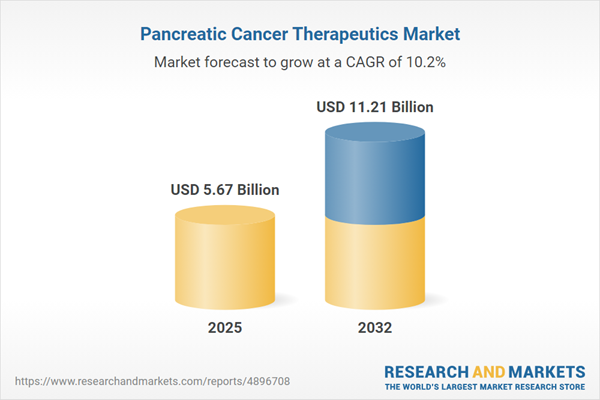Speak directly to the analyst to clarify any post sales queries you may have.
The pancreatic cancer therapeutics market is shifting rapidly as biopharmaceutical breakthroughs, regulatory advancements, and a growing emphasis on precision oncology drive new opportunities for healthcare leaders. Executives face a dynamic landscape shaped by changing protocols, innovative therapies, and global expansion trends.
Market Snapshot: Pancreatic Cancer Therapeutics Market
The global pancreatic cancer therapeutics market is projected to grow from USD 5.14 billion in 2024 to USD 5.67 billion in 2025, ultimately reaching USD 11.21 billion by 2032. Growth at a CAGR of 10.23% is supported by steady oncology protocol innovations, renewed investment from biopharmaceutical leaders, and intensified demand for novel cancer treatment options. Global adoption is expanding throughout North America, Europe, Asia-Pacific, the Middle East, and Africa, as regional healthcare providers adjust strategies to meet evolving clinical and commercial needs. Accelerated product pipelines and favorable regulatory environments are further increasing uptake worldwide.
Scope & Segmentation
This report offers senior executives clear, actionable insights into the complex drivers, opportunities, and operational risks shaping the pancreatic cancer therapeutics market. Deep market segmentation allows effective prioritization of initiatives, technology adoption, and allocation of resources across critical market segments:
- Therapeutic Modality: Reviews evolving trends across chemotherapy, immunotherapy, targeted therapies, and combination regimens, all supporting movement toward highly personalized patient management and encouraging new clinical technology adoption.
- Drug Class: Assesses the market for cellular therapies, monoclonal antibodies, peptides, and small molecules, focusing on how each drug class supports enhanced clinical outcomes and fuels sustained pipeline development for advanced therapies.
- Treatment Line: Examines emerging models around primary, secondary, and tertiary treatments, highlighting opportunities for care personalization as patient requirements evolve through the treatment continuum.
- Route of Administration: Provides an analysis of intravenous, oral, and subcutaneous drug delivery, examining their impact on access, patient-centered care, and operational efficiency in diverse healthcare settings.
- End User: Details market dynamics in cancer centers, hospitals, specialty clinics, and home healthcare, reflecting increased decentralization and the growing importance of adaptable service delivery platforms to support expanding patient needs.
- Geography: Explores regional differences, examining reimbursement structures, regulatory shifts, and varying commercial practices to help inform territory-specific strategy and competitive positioning.
- Leading Companies: Features competitive profiles of Bristol-Myers Squibb, Merck & Co., F. Hoffmann-La Roche, Eli Lilly, Pfizer, Novartis, AstraZeneca, Johnson & Johnson, Sanofi, and Bayer, with insights into recent clinical innovations and pipeline momentum.
Key Takeaways for Senior Decision-Makers
- Immunotherapy and targeted interventions are leading organizations to realign clinical procedures and bolster patient-centric strategies in oncology care.
- Adoption of next-generation diagnostics is enabling precision medicine and tailored therapy selection, enhancing alignment with increasingly diverse patient profiles and clinical demands.
- Combination therapy models are offering adaptive care management, giving providers agility to align treatment protocols with real-time patient response patterns.
- Proactive surveillance of regulatory and reimbursement trends remains critical for stable operations and informed planning across both mature and emerging healthcare markets.
- Implementation of digital technologies and advanced supply chain solutions is reducing operational risks, enabling seamless access, and building resilience as market conditions evolve globally.
Tariff Impact: Navigating Policy-Driven Cost Structures
Recent changes to U.S. tariffs affecting pharmaceutical ingredients and equipment are reshaping cost structures for companies operating within the pancreatic cancer therapeutics market. Market participants are mitigating these impacts through supply chain diversification, increased local sourcing, and investment in automation. Ongoing vigilance across the value chain is essential to maintain supply continuity and support therapeutic innovation, even as policy landscapes become increasingly complex.
Methodology & Data Sources
This analysis is informed by direct input from oncology clinicians, regulatory affairs experts, and C-suite leaders at biopharmaceutical firms. Data sources include proprietary market research, verified clinical trial outcomes, peer-reviewed industry literature, and official regulatory documentation to provide an accurate, decision-ready perspective.
Why This Report Matters
- Equips leadership with foresight to adjust operational and market strategies as the therapeutic and regulatory landscape evolves.
- Provides structured segmentation and thorough regional analysis to guide market entry, expansion, and strategic alignment with prevailing healthcare developments.
- Facilitates proactive payer management and enhances patient access by informing leaders of evolving reimbursement dynamics across regions.
Conclusion
This report gives executives clear direction for strategic planning, positioning organizations to remain agile and responsive as advances in pancreatic cancer therapeutics reshape the global healthcare arena.
Additional Product Information:
- Purchase of this report includes 1 year online access with quarterly updates.
- This report can be updated on request. Please contact our Customer Experience team using the Ask a Question widget on our website.
Table of Contents
3. Executive Summary
4. Market Overview
7. Cumulative Impact of Artificial Intelligence 2025
Companies Mentioned
The companies profiled in this Pancreatic Cancer Therapeutics market report include:- Bristol-Myers Squibb Company
- Merck & Co., Inc.
- F. Hoffmann-La Roche Ltd
- Eli Lilly and Company
- Pfizer Inc.
- Novartis AG
- AstraZeneca PLC
- Johnson & Johnson
- Sanofi S.A.
- Bayer AG
Table Information
| Report Attribute | Details |
|---|---|
| No. of Pages | 196 |
| Published | November 2025 |
| Forecast Period | 2025 - 2032 |
| Estimated Market Value ( USD | $ 5.67 Billion |
| Forecasted Market Value ( USD | $ 11.21 Billion |
| Compound Annual Growth Rate | 10.2% |
| Regions Covered | Global |
| No. of Companies Mentioned | 11 |









